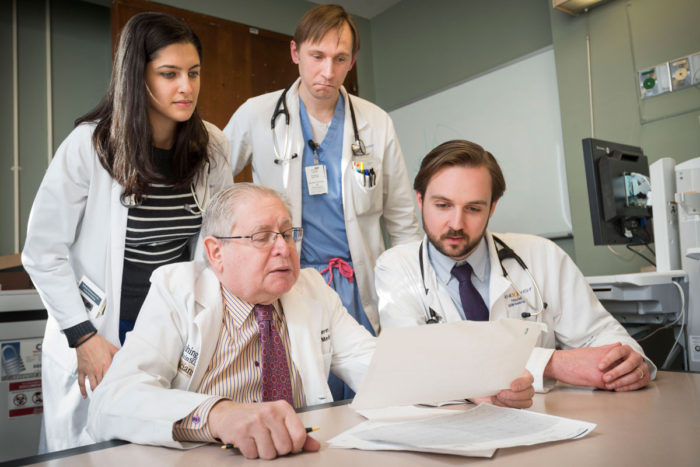New standards promote healthy learning environment for physicians
Med school medical historian played key role in revisions
 Matt Miller
Matt MillerMedical historian Kenneth Ludmerer, MD, (lower left) talks Wednesday, Dec. 13, on the Medical Campus with residents (from left) Stephanie Velloze, MD, Hunter Lanier, MD, and Michael Iglesia, MD, about new national standards for residency training. Ludmerer, who has written extensively on medical education, played a key role on the task force that developed the revisions.
Developing requirements for residency training is a complicated job. It requires balancing a belief in medicine as a profession that exists to take care of patients, while affirming the need for a humane learning environment for trainees. A task force of the Accreditation Council for Graduate Medical Education (ACGME), the organization responsible for accrediting American medical residency programs, recently released new standards for physicians in training. These revisions address work hours and the learning environment for residents, quality of patient care and other topics important in medical training.
Kenneth Ludmerer, MD, the Mabel Dorn Reeder Distinguished Professor of the History of Medicine at Washington University School of Medicine in St. Louis, served on the 21-member task force. Ludmerer, a renowned medical historian and educator, also is a professor of medicine at the medical school and a professor of history in Arts & Sciences.
In the development of the new standards, Ludmerer’s ideas on graduate medical education helped provide the intellectual foundation (and much of the key wording) of the document.
He discussed the new standards below:
Describe your role on the task force.
It was an honor for me that everyone on the task force read my book on the residency system, “Let Me Heal,” and that the co-chairs asked me to write a scholarly paper (later published) on the educational principles of residency training. Being present during the deliberations allowed me to answer questions, clarify issues and help direct the conversation.
What, in general terms, is recommended in these new standards?
In the broadest sense, the new standards defend the residency system as university-level professional education, as opposed to vocational training. This higher educational goal is accomplished by returning much greater freedom to residents in how they choose to use their time; by emphasizing the academic characteristics of the learning environment; and by various recommendations aimed at increasing resident engagement in their work.
What do you think are the most important standards and why?
General limitations on work hours remain (for example, the 80-hour maximum work week), but restrictions on shift length have been removed. This allows house officers to focus on resident learning and on their patients and not on the clock. In addition, the new rules require a more manageable patient load and much greater help with chores than in the past. This means that the Accreditation Council for Graduate Medical Education cares not just about the hours of work but with how those hours are used.
Why have resident work hours been the subject of debate for many years?
In some cases, residents in the past have been expected to work long hours and carry a large workload, not all of which was professional.
Twenty years from now, how do you hope the experiences of physicians in training have changed?
Residency education will always evolve, as medical knowledge, medical practice, the health-care delivery system, and cultural mores continue to change. However, my fondest hope is that residency education will maintain high intellectual standards and its focus on service. This means producing doctors whose medical knowledge is deeply rooted in the underlying science, who are skilled at obtaining information from patients, who are adept at problem-solving and managing uncertainty, who genuinely care about the well-being of their patients, and who understand the role of the physician and the place of medicine in the broader society.






